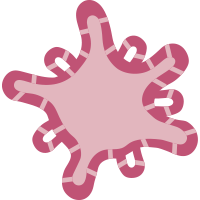
Organoid News
Organoid News is an online resource dedicated to the latest research about and featuring organoids.
Single-Cell Profiling Demonstrates the Combined Effect of Wheeze Phenotype and Infant Viral Infection on Airway Epithelial Development
[Science Advances] Researchers characterized nasal airway epithelial cell (NAEC) developmental phenotypes from children aged 2 to 3 years in an a priori designed nested birth cohort from four mutually exclusive groups of wheezers/nonwheezers and respiratory syncytial virus–infected/uninfected in the first year of life.
Mucinous Breast Cancer Organoids: An In Vitro Research Model
[Discover Oncology] Scientists obtained surgical tumor samples from a 64-year-old Chinese female patient diagnosed with pure mucinous breast cancer to establish patient-derived organoids.
Latest Advanced Techniques for Improving Intestinal Organoids Limitations
[Stem Cell Reviews and Reports] Investigators elucidate the principal limitations of intestinal organoids and investigate structural defects.
TGF-β Signaling Redirects Sox11 Gene Regulatory Activity to Promote Partial EMT and Collective Invasion of Oncogenically Transformed Intestinal Organoids
[Oncogenesis] Researchers used intestinal organoids with colorectal cancer driver mutations as model system to investigate the mechanistic basis of TGF-β1-induced partial epithelial-mesenchymal transitions and collective invasion.
Bat Organoids Reveal Antiviral Responses at Epithelial Surfaces
[Nature Immunology] The authors developed respiratory and intestinal organoids that recapitulate the cellular diversity of the in vivo epithelium present in Rousettus aegyptiacus, the natural reservoir for the highly pathogenic Marburg virus.
Establishment of Salivary Tissue-Organoid Biorepository: Characterizing Salivary Gland Stem/Progenitor Cells and Novel Differentiation Marker PSMA/FOLH1
[npj Regenerative Medicine] The authors established the first diverse and clinically annotated salivary regenerative biobank at Mayo Clinic to study salivary gland stem/progenitor cells.
Microfluidic Bioprinting As a Tool to Produce hiPSCs-Derived Renal Organoids
[Biofabrication] Investigators established differentiation protocols to obtain hiPSC-derived metanephric mesenchyme, ureteric bud progenitors, and the com-bination of these was used to form organoids.
Enhanced Application Potential of Alveolar Organoids through Epithelial and Niche Cell Interactions
[Scientific Reports] Scientists developed alveolar organoids to investigate the complex interactions between alveolar epithelial cells, niche fibroblasts and macrophages, which are essential for lung development, maintenance and repair, especially under physiological injury.
Modeling Hereditary Diffuse Leukoencephalopathy with Axonal Spheroids Using Microglia-Sufficient Brain Organoids
[Elife] Investigators used a macrophage and forebrain organoid co-culture system based on iPSCs generated from two patients with hereditary diffuse leukoencephalopathy with axonal spheroids, with colony stimulating factor-1 receptor gene-corrected isogenic organoids as controls.
Construction of a Metastasis Model for Liver Cancer Spheroids to Hepatobiliary Organoids Facilitated by Holographic Acoustic Tweezers
[Cell Reports Physical Science] Scientists assessed the biosafety of three-dimensional holographic acoustic fields on organoids and spheroids at the cellular and genetic levels, optimizing the parameters for manipulation.
Stefan Mereiter Receives FWF Funding for International Research Project
[Medical University of Vienna] Stefan Mereiter has been awarded a grant from the Austrian Science Fund FWF. The project investigates sialylation - the targeted attachment of sialic acid to proteins and lipids in the body.
Post-Gastrulation Amnioids As a Stem Cell-Derived Model of Human Extra-Embryonic Development
[Cell] Researchers presented an ESC-derived 3D model of the post-gastrulation amnion, post-gastrulation amnioids, that faithfully recapitulates extra-embryonic development up to four weeks post-fertilization, closely mimicking the functional traits of the human amniotic sac.
Organoids are three-dimensional cell cultures that more accurately model cell behavior, organ function, and pathology than traditional two-dimensional cell culture. Organoid News was launched in 2020 to help scientists stay up-to-date with this revolutionary new research system. Use Organoid News to stay current with the latest applications and discoveries using organoids, as well as new reviews, jobs, news, and upcoming events.

 Cancer Stem Cell News
Cancer Stem Cell News Cell Therapy News
Cell Therapy News Dermal Cell News
Dermal Cell News Endothelial Cell News
Endothelial Cell News ESC & iPSC News
ESC & iPSC News Extracellular Matrix News
Extracellular Matrix News Hematopoiesis News
Hematopoiesis News Hepatic Cell News
Hepatic Cell News Human Immunology News
Human Immunology News Immune Regulation News
Immune Regulation News
 Intestinal Cell News
Intestinal Cell News Mammary Cell News
Mammary Cell News Mesenchymal Cell News
Mesenchymal Cell News Muscle Cell News
Muscle Cell News Neural Cell News
Neural Cell News Organoid News
Organoid News Pancreatic Cell News
Pancreatic Cell News Prostate Cell News
Prostate Cell News Pulmonary Cell News
Pulmonary Cell News
